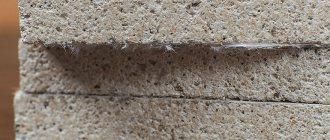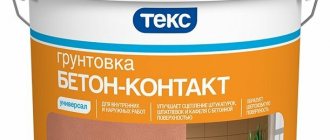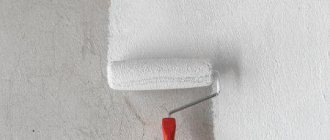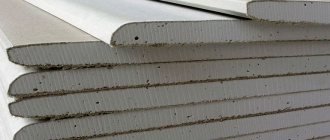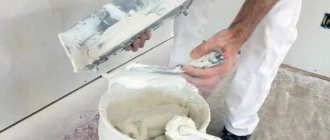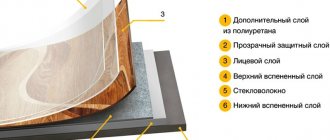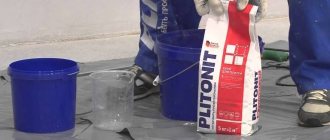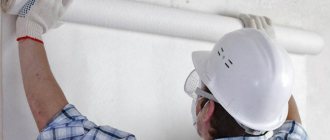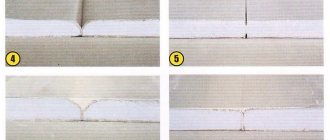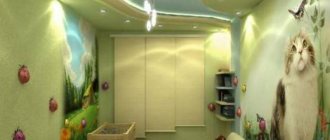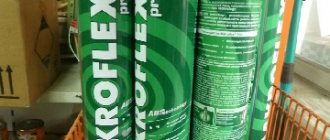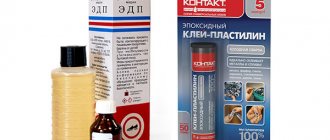Drywall has long become a classic when it comes to repairs. The relatively inexpensive material is versatile enough to be used in a variety of situations. And ease of handling plays an important role. The poor reaction of gypsum to a humid environment led to the creation of GKLV, which stands for moisture-resistant plasterboard sheet.
The new material began to be used in rooms where humidity could reach 85%. First of all, we are talking about baths, showers and toilets. However, over time, waterproof plasterboard began to be used wherever possible. Sometimes it makes sense to use moisture-resistant drywall in an unheated room where there is a lot of dampness.
Scope of application
As already written above, moisture-resistant drywall is ideal for use in bathrooms, where it is most often used. Regular drywall is not suitable for these purposes. GKLV is often also used in shower cabins, but it must be covered with tiles.
Balconies and loggias, regardless of whether they are heated or not, can be repaired using waterproof plasterboard. This material is also in demand when working with areas near the pool. It is also suitable for finishing a garage.
GKLV is often used in the kitchen, although in many situations this is not so necessary. But you need to use it for door and window slopes, because in these places the humidity is higher than in other parts of the room . To figure out how and where to use moisture-resistant drywall, you need to pay attention to its advantages:
- universal in use;
- easy to install;
- good hydrophobic properties;
- the presence of sound and noise insulation properties;
- non-toxic;
- the finished surface can be covered with a variety of materials;
- can be given the desired shape.
The optimal way to tile a bathroom with plasterboard
In small rooms with smooth walls, drywall can be attached using glue. But if in the future you plan to decorate the walls with tiles, then it should be secured with a frame.
The frame method is an excellent option for uneven walls, allowing you to close all communications and create a screen for the bath. Also, in this case, there is no need to clean the walls from the previous coating. While performing this work you will need:
- Rack profile 50x50 (galvanized metal or aluminum);
- Guide profile 50x40;
- Direct hangers;
- Galvanized dowels and screws;
- Level and plumb;
- Hammer.
Attention! Do not use wooden profiles to create the frame. Wood is susceptible to moisture, so in a room with high humidity it will soon become unusable.
Before installing the frame, it is necessary to hide all electrical wires in soft corrugated plastic hoses. The corrugation will protect them from the harmful effects of moisture, mechanical damage and prevent short circuits against the metal profile.
Before installing drywall, you must carefully hide the wires
Also, before installing the frame, metal pipes should be coated with primer twice. Then you need to ensure their thermal insulation: wrap them with mineral wool or other insulators designed specifically for these purposes. There must be a distance of at least 3 cm between the pipes and waterproof drywall. Special inspection doors must be inserted at the locations of valves and meters.
The main differences from gypsum boards
First you need to understand how to find the material of interest and distinguish it from others. The simplest thing is to pay attention to what color the moisture-resistant drywall is. It should be green or light green, while regular drywall is framed in gray. If this is not enough, then marking moisture-resistant drywall will help dispel all doubts. On ordinary sheets they write gypsum board, and on waterproof sheets - gypsum board.
However, not only visual differences are important, which will help you find the right material in a hardware store. Once you know how to differentiate moisture-resistant drywall from regular drywall, there are other important factors to consider.
- The weight of the moisture-resistant sheet is greater due to special additives, which allow it to withstand conditions of high humidity. As a result, it turns out that gypsum board is about 2 kilograms heavier than gypsum board. The weight of one square meter of wall plasterboard is 10 kg .
- The cardboard layer itself is additionally impregnated with antifungal and other drugs to prevent water from penetrating into the core, causing mold and other negative influences.
The dimensions and characteristics of moisture-resistant plasterboard will help you understand where and how best to use it.
The best drywall: color scheme
- White-gray. This is a classic. It is chosen when increased requirements for moisture resistance and temperature are not required. It has a low price. Popular.
- Green. Indicates that the sheets are highly resistant to moisture. It is green plasterboard that is purchased for finishing bathroom walls.
- Yellow. Created for finishing facades. Resistant to natural disasters and humidity.
Drywall
differs in the shape of the edge. For example, a rectangular edge (RK) indicates the use of the material in dry types of work without puttying; with beveled edges (UK), the ends are sealed with reinforcing tape. Rounded edges (RC) are used for sealing without reinforcing tape.
Here are all the nuances that are important to know when purchasing drywall.
Typical sizes
Waterproof drywall is available in several possible sizes:
- 1.2x2 meters - convenient to use due to low weight due to small size;
- 1.2x2.5 meters - this size of moisture-resistant plasterboard sheet 12.5 mm thick is the most popular;
- 1.2x3 meters - due to the large weight (36 kg per sheet) and dimensions, it is very difficult to use and bring into the room.
Possible sheet parameters
In addition to width and length, we are also interested in thickness:
- 12.5 mm – classic option for mounting to walls;
- 9.5 mm – special modification for working with ceilings (less weight and less load);
Thanks to the use of standard sizes in the production of plasterboard sheets, they can be combined in work, regardless of whether they are ordinary or moisture-resistant.
The thickness of moisture-resistant plasterboard is important only if it will be used for the ceiling. It is difficult to lift massive sheets above your head, and the heavier the plasterboard, the more fastenings are required. Moreover, such sheets do not protect against flooding by neighbors, so for the ceiling, the smaller the thickness, the better.
Other characteristics
In addition to dimensions and moisture-repellent additives, you can pay attention to the technical parameters of the material and the type of edge. Usually no one looks at the edge, although this is a very important point. It is very often trimmed and then puttied, but this violates the integrity of the cardboard shell. Therefore, it makes sense to think about choosing a sheet with an edge that will not need to be trimmed. There are 5 types of edges.
- Rounded.
- Straight.
- Semicircular.
- Sophisticated.
- Semicircular and refined.
This is what the edge of a gypsum board may look like.
Each gypsum board has a certificate of conformity. These certificates indicate the main characteristics of the material that are worth paying attention to. If you buy drywall from a well-known brand, then everything is in order with the certificates. However, if you take cheaper products, you need to make sure that the moisture-resistant drywall meets all GOST standards. It is necessary to check the material for the following compliance:
- toxicity group T1;
- flammability group G1;
- flammability group B3;
- smoke generation group D1;
The certificate of conformity states that the material is safe for human health and not dangerous during operation.
Sample certificate of conformity
It is believed that GKLV lasts approximately 10-15 years. And the point is not so much that the material wears out, but that it is easy to damage. One blow with your fist and it will become unusable. Therefore, the service life of moisture-resistant drywall for outdoor use is even shorter. The environment is more aggressive not only because of the weather, but also because of the possibility of unwanted mechanical impact.
How to Choose the Best Drywall: A Guide
Smart buyers, when choosing plasterboard, first of all pay attention to the complexity of the tasks, and not to the manufacturer, because for various surfaces it is advisable to choose your own option, for example, for the ceiling - ceiling plasterboard, for walls - wall plasterboard, and for arches - arched, each of them has its own unique properties.
Depending on the purpose, you should choose standard slabs or dfhbfyn, which has additional fire resistance or moisture resistance, you can choose laminated, restoration or other options.
To choose high-quality drywall you need to adhere to the following rules:
- In order not to buy stale goods, you need to avoid large sites, including markets, as well as dubious stores that are not in particular demand. It is necessary to contact specialized stores, preferably from manufacturers.
- You shouldn’t take the seller’s word for it, you need to check the product yourself, see how it is stored, ask for a small sample (a conscientious seller will never refuse) and see what it looks like inside, break it (high-quality material should not crumble too much), if you see If you come across damp or damaged drywall, under no circumstances should you buy it from such an establishment.
- If the chosen point of sale and the supplier inspire confidence, then before the purchase itself you need to carefully examine it for various external defects. There should be no curves or corners, surfaces should be perfectly smooth without scratches or roughness.
- After suitable samples have been selected and checked for quality, you will need to monitor the quality of their delivery (the work of the loaders must be careful and careful, because all repairs will depend on this).
- You shouldn’t rush to make a choice; if the repairs are quite large-scale, it’s better to buy a small batch for testing, but if the quality does not cause any complaints, you can order the required quantity.
- You shouldn’t save on gypsum boards; you don’t have to overpay for the brand, but not for the quality.
Installation and operation
When working with moisture-resistant drywall, there are no particular difficulties, but there are some small nuances. For example, the weight of the sheet is greater than usual, which means that assistance may be required, because even if it is cut, it will be heavy.
It is recommended to use gypsum plasterboard only in rooms where there is a ventilation system to prevent condensation from accumulating.
Moisture-resistant plasterboard is suitable for finishing walls and ceilings
The question often arises as to which side to mount moisture-resistant drywall. Wall and ceiling gypsum boards are attached according to the same principle, with the convex side outward, just like ordinary plasterboard sheets. A waterproof sheet does not have any special side that better protects against moisture. Although some craftsmen prefer to additionally treat the sheets with antifungal and hydrophobic materials on both sides for greater reliability.
Some even think about how to make drywall moisture resistant with their own hands. They independently impregnate ordinary sheets of drywall, but in fact this is a waste of effort, and the benefits of such work are very doubtful.
In all other installation issues there is no difference between gypsum boards and gypsum boards.
Reader questions: how to choose the best drywall
Good afternoon. I decided to ask how to choose drywall to create a two-tier ceiling structure. Now I have taken a well-deserved leave due to age. There is a lot of free time. That’s why I decided to do the repairs myself, besides, there is now so much information on this topic that only the lazy would not be able to do anything with their own hands. I chose the shape of the ceiling and mastered the technology. And I decided to ask how much the sheathing would cost. I went to the store, and there was such a huge assortment of material that it made my eyes wide open. It is not clear what plasterboard sheets to use for the ceiling. An attempt to calculate material costs was unsuccessful. First you need to figure out what material to take. Experts, tell me which sheets are best to buy for the ceiling?
For home repairs, only a few basic types of drywall are used from the entire available range. The sheets differ in:
- sizes;
- characteristics;
- shades.
